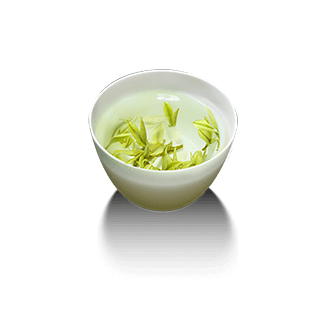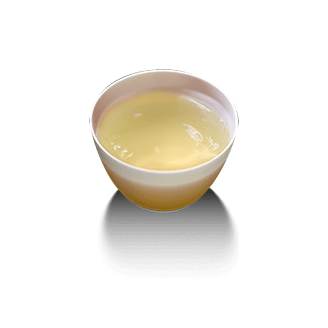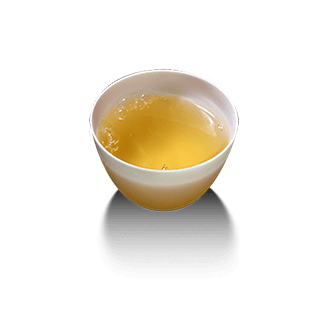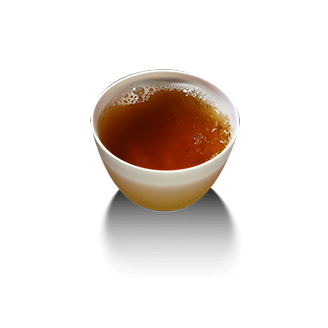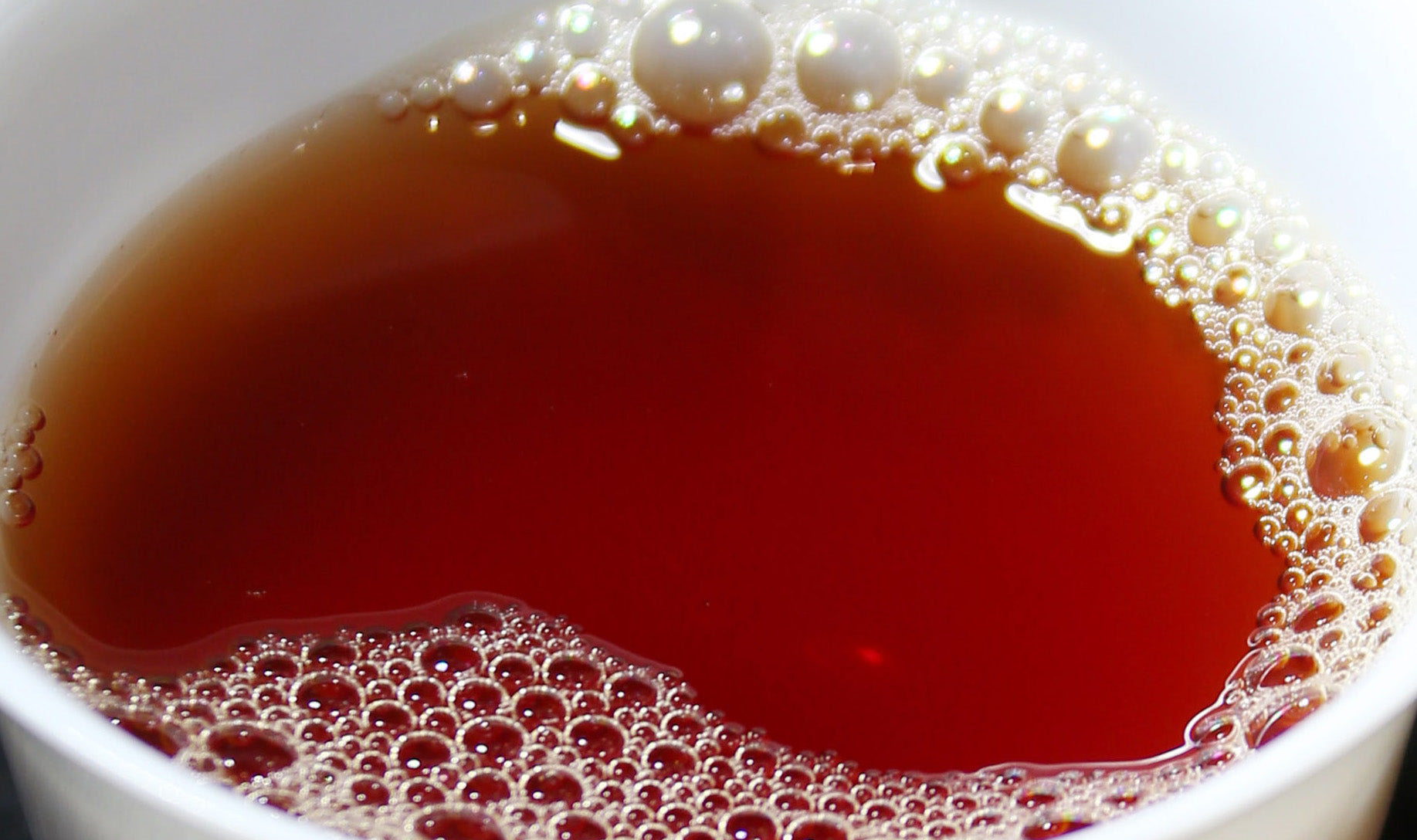



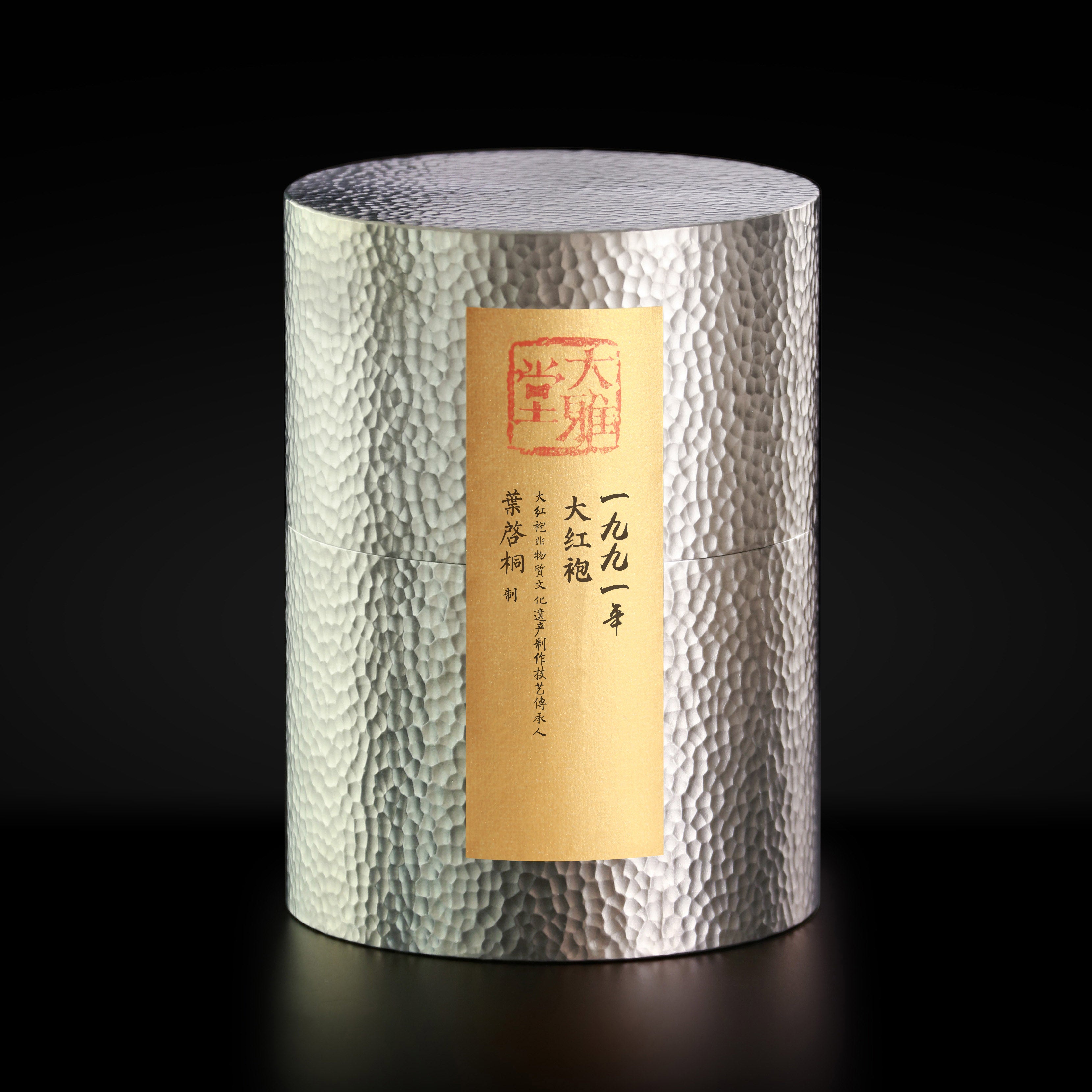
Ye Qitong's 1991 Da Hong Pao






Ye Qitong's 1991 Da Hong Pao

Inheritor of the National Intangible Cultural Heritage — Wuyi Rock Tea Production Techniques, and Senior Tea Taster in Wuyi Mountain.
with long-term engagement in the production,
processing, and research of Wuyi Rock Tea.
He presided over the development of two national standard samples of Wuyi Rock Tea (2004, 2006).
Ye Qitong is an elder statesman in the current Wuyi Rock Tea industry,
and one of the respected tea experts.
叶启桐
Tea Industry Master & ICH Inheritor
My mentor Mr. Ye is the most revered grand master in my heart.
He is simple, sincere and unwavering in character, and profound and insightful in his craft.
Years ago in Xiamen, I had the honor of listening to his teachings in person at his home.
What this grand master of Wuyi rock tea said resonated with my holistic understanding of tea — the so-called fine tea is inherently the truest taste of nature.
A flawless tea is inherently hard to find, for nature's creations are never perfect; yet it is the craftsman's hands that turn imperfection into perfection..

The Birth of Fine Tea Rests First on Heavenly Timing, and the weather is undoubtedly the "number one contributor".
Tea trees require favorable weather—neither drought nor waterlogging—during their growth;
Harvesting calls for clear, pleasant days, free of rain and scorching sun — if it rains or swelters, the picked tea tends to taste astringent and bland, making it hard to become a premium product.
The mystery of light holds even more secrets of tea: light of different wavelengths prompts the production of different internal substances in tea trees.
Red light promotes the accumulation of tea polyphenols, while blue-violet light aids the production of amino acids and proteins.
And the logic behind the ancient saying "Fine tea comes from high mountains shrouded in mist" lies precisely in this light and shadow:
Amid the mist of high mountains, short-wavelength blue-violet light can penetrate the rain and fog, enhancing the nitrogen metabolism of tea trees. This allows the leaves to accumulate ample amino acids, caffeine, and aromatic substances, resulting in full freshness and rich aroma.
As the ancient saying goes, "Do not pick tea in rain, nor in scorching sun, only in clear weather" — this is precisely aligning with the tea trees' "rhythm of growth".
The weather is ever-changing, and the taste of tea changes with it. Fine tea has always been a gift from heaven.
Every mountain boasts a unique tea rhyme;
Every hollow and gorge yields a distinct nuance of flavor;
Even every wild tea tree offers a one-of-a-kind taste!
—— Where tea grows, its flavor resides.
Growing alongside fresh flowers, tea absorbs an elegant floral fragrance;Living in harmony with moss, tea carries a subtle moistness of moss.
Only a fine ecosystem can nurture tea's inherent rhythm, rock rhyme, or rich floral and fruity notes.
Just as the weathered rock soil of Wuyi Mountains endows Wuyi rock tea with its unique "rock bone";The yellow-red soil (slightly acidic) of Taimu Mountain lends white tea a lingering rhyme;
And there are also Huangshan Mountain, Jingmai Mountain, Nannuo Mountain, Mengding Mountain...
Every place endowed with exceptional natural beauty nurtures fine teas of distinct flavors, thanks to the unique water and soil.
The rhyme of tea truly stems from the nurturing of its origin.
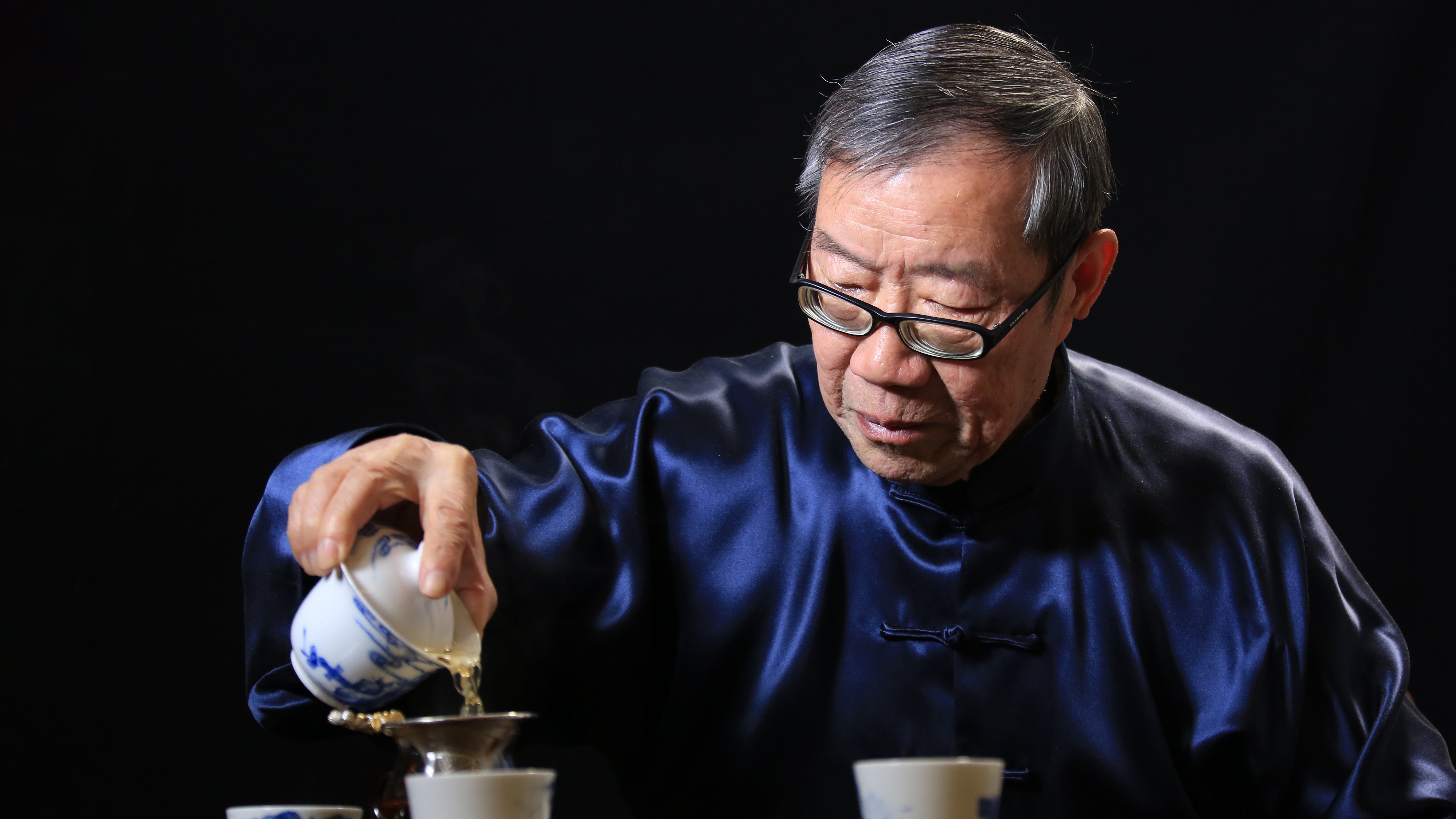
People and tea are inherently in a state of fusion and unity.
Only those who truly understand tea, and can infuse this understanding into tea-making in the most delicate way, have the potential to become a Tea Master or an inheritor of the intangible cultural heritage (ICH) of tea-making.
Every ICH inheritor has their own unique insights and distinctive techniques.
Yet all of them have mastered the skill of "making tea according to the weather and the tea itself":
They align with the rhythms of heaven and earth, adjust the craft according to the weather, control the details based on the state of the tea leaves, and ultimately endow the tea with a unique character.
Therefore, every tea refined with genuine craftsmanship is a one-of-a-kind work.
If one is fortunate enough to encounter a favorite tea, it is a wonderful tea fate—
like meeting a soulmate in a vast crowd. A fine tea is the harmony of heaven, earth and humanity!

Master Ye Qitong once specially kept a batch of 1991-vintage Da Hong Pao and spoke highly of it.
Originally packaged in a large iron box, this tea is a cherished keepsake of Master Dayatang — hence a custom-made sandalwood-carved collection case was crafted for it, holding the stories of time woven into Wuyi rock tea.
Wuyi rock tea is inherently "nurtured by the essence of mountains and rivers", where tea and landscapes complement each other perfectly.
The preciousness of aged tea lies in its "purity, mellowness and harmony" — after years of precipitation, it still retains its original flavor, untainted and uncluttered.
This is the most treasured aged tea of Master Dayatang.
The quality of the tea's raw materials, along with the craftsmanship and significance embodied in its making, have long surpassed the "age" itself.
This cup of tea is a gift from heaven and earth, a crystallization of craftsmanship, and even more a witness to the passage of time.
Ye Qitong, National ICH inheritor presented
Vintage 1991 Da Hong Pao
Appreciation
Aged Aroma, Timeless Craftsmanship
Appreciation of Ye Qitong's 1991 Plum Aroma Da Hong Pao: In the world of Wuyi rock tea collecting,the encounter between vintage years and master craftsmanship often forges legends. The 1991 Plum Aroma Da Hong Pao is such a tea – it not only bears the weight of nearly 40 years of time-honored aging, but also, thanks to the personal involvement and high praise of Mr. Ye Qitong, National ICH inheritor, it has become a "timeless treasure" among collectors and tea connoisseurs.
This aged tea, specially preserved by Mr. Ye and cherished by Daya Hall, breaks the one-sided notion that "older tea is inherently more valuable for prolonged storage". With its core traits of "clean purity and mellow smoothness", it perfectly embodies the philosophy: "Quality as the foundation, craftsmanship as the soul, and time as the lingering charm".
Vintage : 1991
Grade : Premium Grade
Supervisor : Ye Qitong, National ICH inheritor of Wuyi Rock Tea (Da Hong Pao) Production Craft
Origin : Core Zheng Yan Production Area, Wuyi Mountain
Variety : Da Hong Pao
I. Background: Craftsmanship as the foundation, time as the witness
When it comes to the significance of this tea, the foremost elements are the "people" and "fate" behind it. Mr. Ye Qitong, a representative inheritor of the Wuyi rock tea making craftsmanship, has dedicated himself to the field of rock tea for decades. His selection of raw materials and control over craftsmanship have long become industry benchmarks.
In 1991, Mr. Ye personally participated in the production of this batch of Da Hong Pao. From the screening of raw materials from the tea-growing regions (shan chang) to the finalization of the roasting process, he infused his unique craftsmanship and dedication. After the production was completed, he specially kept this batch of tea, which is a testament to his recognition of its quality.
Stored in a stable aging environment for decades, isolated from drastic fluctuations in external temperature and humidity, the tea leaves have slowly transformed over time. They have retained the core characteristics of Da Hong Pao while developing the unique mellow and smooth flavor exclusive to aged tea. Originally packed in a large iron box, this tea was later preserved by Master Dayatang in red sandalwood and tin jars. Today, opening the box to taste it is not only a dialogue with a period of rock tea's development history but also a tribute to the spirit of craftsmanship.
II. Appreciation: Savour in Multidimensions, Rhyme Hidden in Time.
1. Dry tea: Observe the Shape to Discern the Quality, Aged Rhyme Emerging Initially
As soon as the packaging is opened, the aroma of the dry tea slowly wafts out—no off-flavours, no warehousing odours, only a clean aged fragrance with a subtle plum rhyme. The tea leaves are tight, plump and sturdy; despite nearly 40 years of aging, they still maintain a complete shape, with a flexible and elastic texture—this is exactly evidence of high-quality raw materials from premium tea-growing regions (shan chang) and exquisite rolling craftsmanship. The colour is dark brown and glossy, interspersed with natural aged hues, free of scorch marks and broken particles. Every single tea strip exudes a texture of "being old yet firm and resilient".
2.Liquor Color: Rich Red and Bright, Mellow Smoothness Fully Revealed.
Take 8 grams of dry tea, awaken it with boiling water at 100°C, and brew it formally after one rinse. When the first infusion is poured out, the liquor color is stunning—it is rich red like amber, clear and bright, with no turbidity or sediment on the cup wall, and a delicate golden rim around the edge. As the number of infusions increases, the liquor color turns slightly pale red, but remains as bright as the first brew. This not only confirms the characteristic that "aged tea is valued for its purity" but also indicates that it was not contaminated at all during the aging process and has undergone a pure transformation.
3. Aroma: Medicinal Aroma with Plum Rhyme, Long-Lasting Cool Aroma.
The elegant rhyme in the aged fragrance of this tea makes its aroma the most intriguing. In the hot lid aroma, a gentle aged fragrance first greets the nose, followed by the interweaving emergence of delicate, mild floral and fruity notes—free of dryness or sharpness, as gentle as the spring breeze brushing against the face. When the cup wall cools slightly, the cool aroma becomes even clearer: pure lingering floral and fruity scents hover in the cup, and when inhaling, one seems to catch the sweet and mellow breath precipitated by time.
4. Taste: Long-Lasting Sweet Rhyme, Hidden Rock Bone.
The first sensation upon the tea liquor touching the palate is "mellowness"—no astringency of unaged tea, no dryness from heavy roasting, only the gentle tea liquor spreading slowly across the tongue. At the first sip, the softness of aged tea dominates; then a natural sweet rhyme emerges at the base of the tongue, wispy and delicate, sliding down the throat and leaving a lasting moistness. After the third or fourth infusion, the unique "rock bone" of Wuyi rock tea gradually reveals itself: a subtle mineral note blends with plum rhyme and sweet rhyme, creating rich yet uncluttered layers. As described, "the sweet rhyme lingers long on the tongue"—even long after the tea liquor is swallowed, the sweet aftertaste continues to release slowly in the mouth.
5. Wet Leaves: Plump, Thick and Flexible, Excellent in Quality.
III. Insights: The Value of Aged Tea Lies in Quality and Craftsmanship.
The process of tasting the 1991 Plum Aroma Da Hong Pao is also a re-understanding of the value of aged tea. Many people mistakenly believe that the value of aged tea lies entirely in "years of aging", but this is not the case—without the core tea-growing region raw materials selected by Mr. Ye Qitong and the exquisite craftsmanship as the foundation, this tea would only become an ordinary tea product that is "aged but not mellow", no matter how many years it has gone through. Its preciousness lies in the triple blessing of "premium tea-growing region + excellent craftsmanship + proper aging", in the infusion of Mr. Ye Qitong's craftsmanship, and more importantly, in its pure quality that remains "unmixed and uncluttered" after years of precipitation.
When a cup of tea is finished, the cool aroma at the bottom of the cup and the sweet rhyme on the tongue still linger. This 1991 Plum-Fragrance Da Hong Pao is not only an aged tea worthy of collection, but also a "living textbook" carrying the craftsmanship and the wisdom of time of Wuyi rock tea—it tells us that truly good aged tea has always been "quality as the foundation, craftsmanship as the soul, and time as the rhyme".
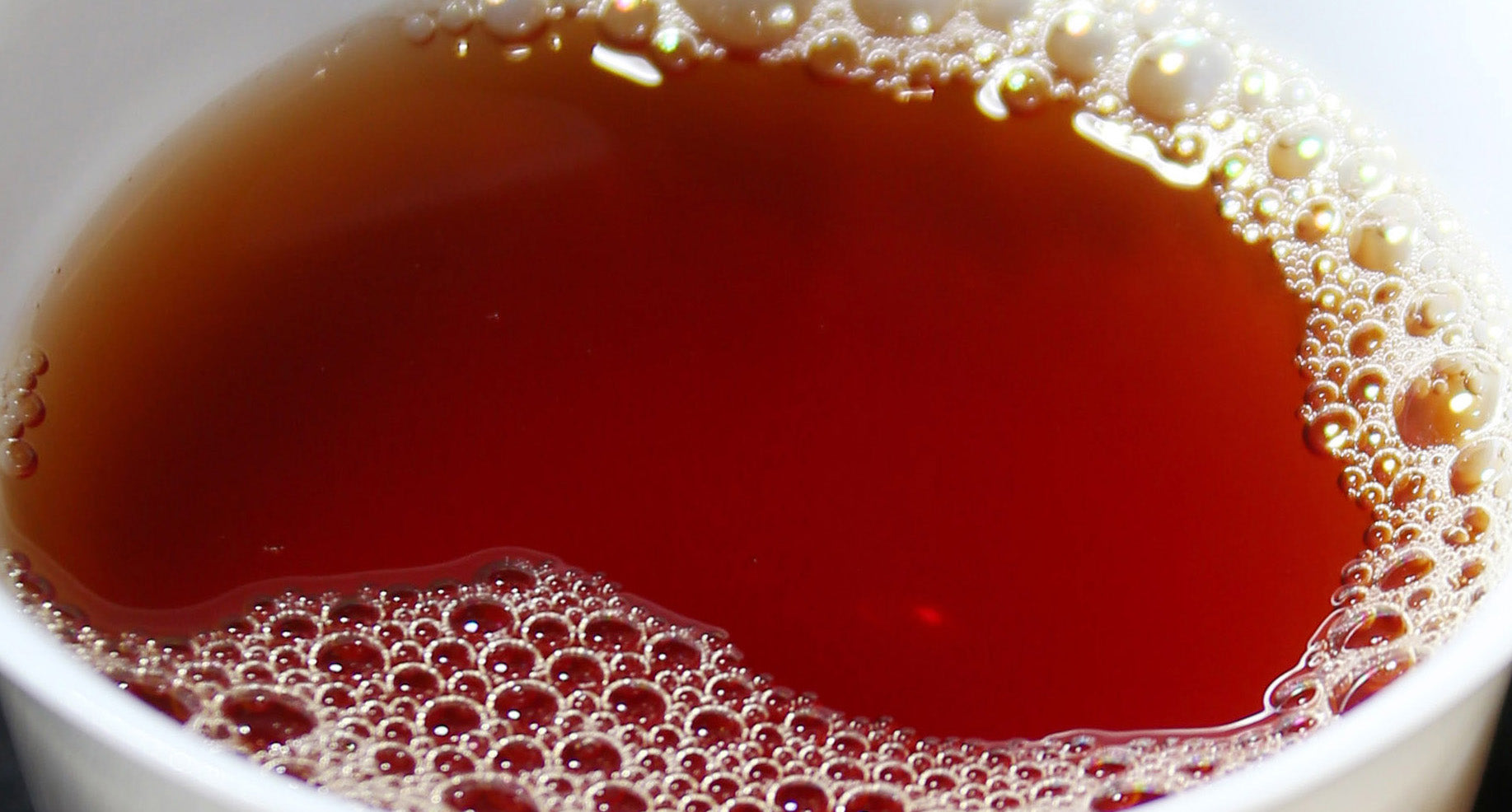
The 1991 Ye Qitong Da Hong Pao tea has an amber-colored, lustrous liquor, displaying the weight of time.
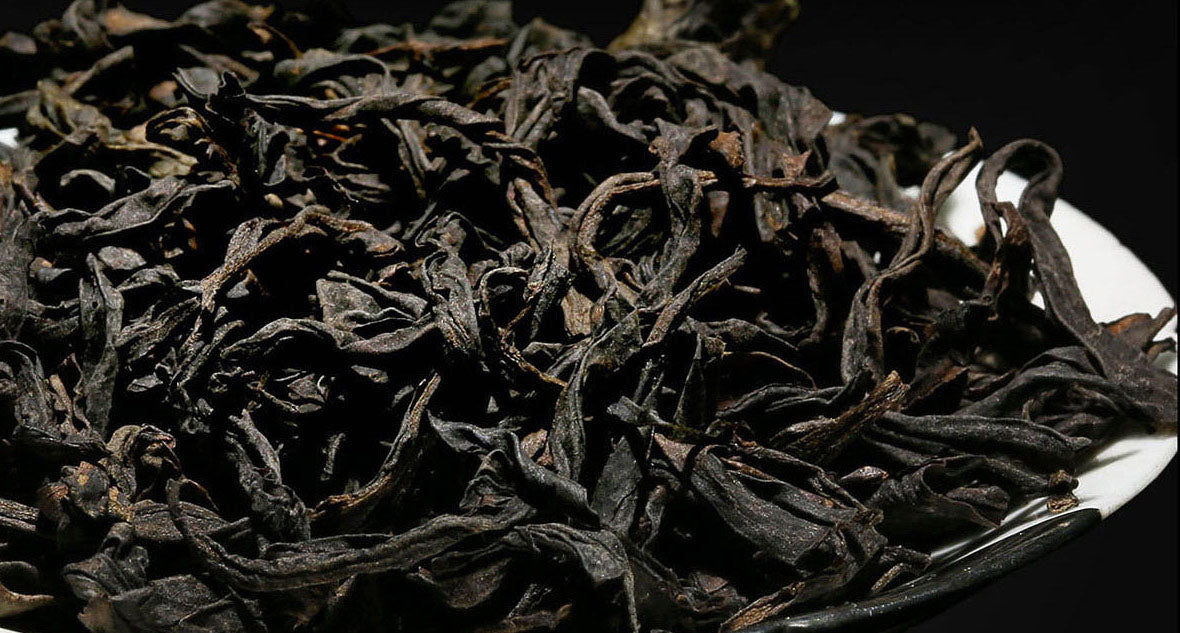
The strips are dark brown with a hint of reddish-brown, showing early signs of aging, yet retaining their original character.
Ye Qitong, National ICH Inheritor
1991 Plum Aroma Da Hong Pao
brewing
Ye Qitong 1991 Plum Aroma Da Hong Pao
brewing

brewing
For this vintage tea aged over 30 years, the core brewing principle is to "awaken plum aroma, preserve aged charm, and highlight rock texture". The streamlined steps are as follows:s:
I. Pre-Brewing Preparation
II. Core Brewing Steps
- Warming utensils : Rinse all utensils with boiling water to maintain a constant temperature above 80℃.
- Add Tea Leaves: Put 8g of tea into the gaiwan.
- Infusion by Steeping Round:
- 1-3 steeping: Pour water along the gaiwan wall at a low height, steep for 5-8 seconds before serving (awakens inherent ingredients, dominated by aged aroma).
- 4-7 infusions: Pour water in a circular motion at a low height, steep for 10-15 seconds before serving (faint plum aroma, rich and smooth liquor).
- After 8 infusions: Pour water at a fixed point at a low height, extend steeping time by 5-10 seconds per round (sweet jujube flavor in the final infusions; avoid steeping over 60 seconds).
- Tasting : Drink within 15 minutes after dividing the liquor. First smell the lid aroma (hot sniff) and cup bottom aroma (cold sniff), then sip slowly.
III. Note
Key Logic
Adapt to the aged characteristics of the vintage tea:
Low-height pouring preserves plum aroma.
Short steeping prevents bitterness.
Constant temperature maintains aged charm.
This allows the faint plum aroma and rock texture accumulated over 30 years to be fully released.

Bois de rose & Filigree Sandalwood Relief Carving & Hoopoe Perching on Branches & Wan" (Eternity) Pattern & Four-Drawer Tea Caddy.
"Forged Through Thousands of Hammers" Handcrafted Pure Tin Can
Height: 15 cm | Diameter: 11 cm | Net Weight: 250 g
Crafted by Sheng Yiyuan, ICH Inheritor of Yongkang Tin Carving.
The can body is shaped through thousands of manual hammer strikes, boasting a delicate and warm texture. Each hammer mark—varying in depth—stands as a unique imprint, a vivid testament to the warmth of handcraftsmanship and the profound meaning of intangible cultural heritage ingenuity.
The interior is finely polished using precision numerical control (NC) technology, ensuring a smooth and burr-free surface. The lid and mouth, crafted with high-precision techniques, achieve an airtight seal. This fusion of handcrafted warmth and modern technical precision preserves ancient charm while guaranteeing practicality.
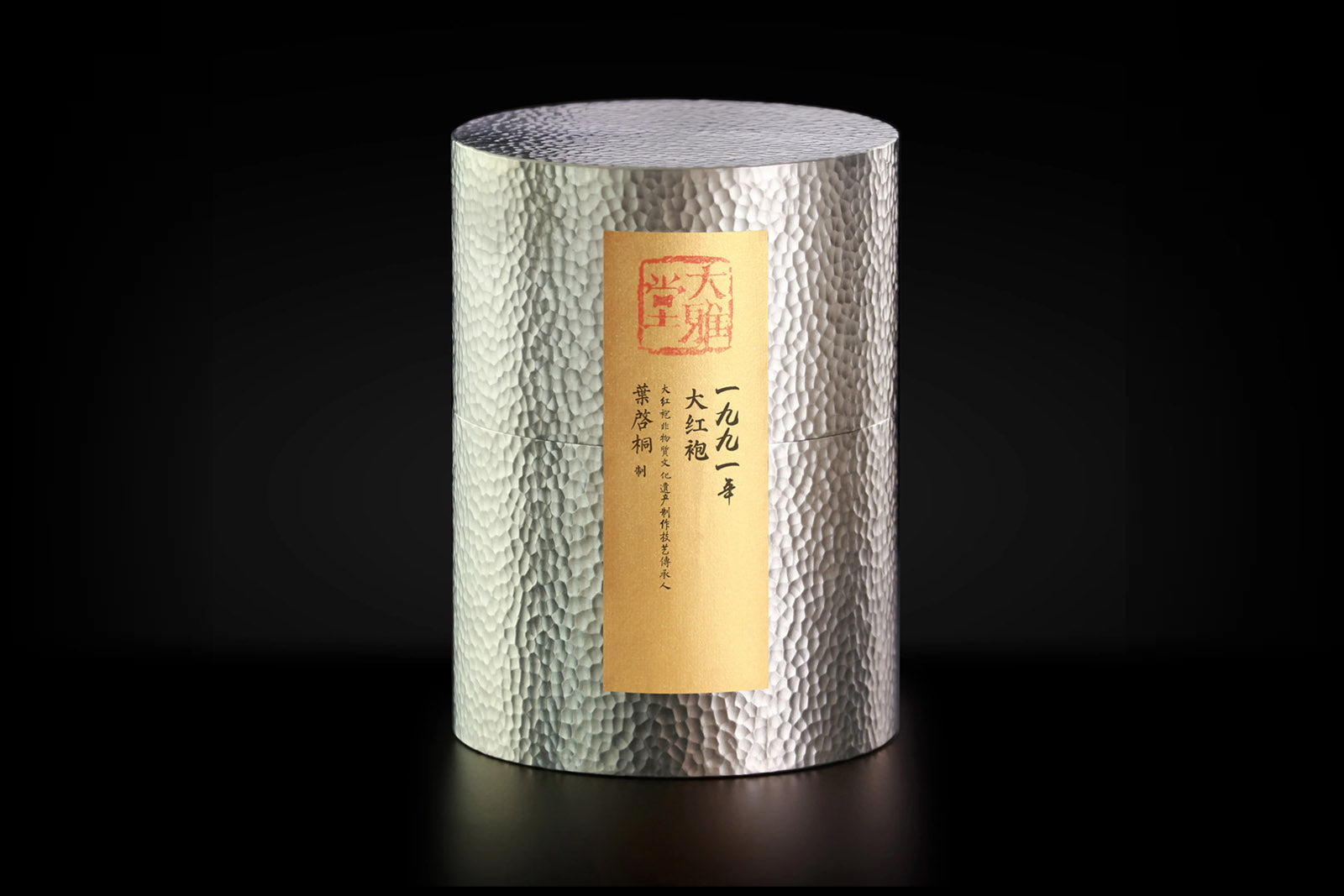
Height: 15 cm | Diameter: 11 cm | Net Weight: 250 g
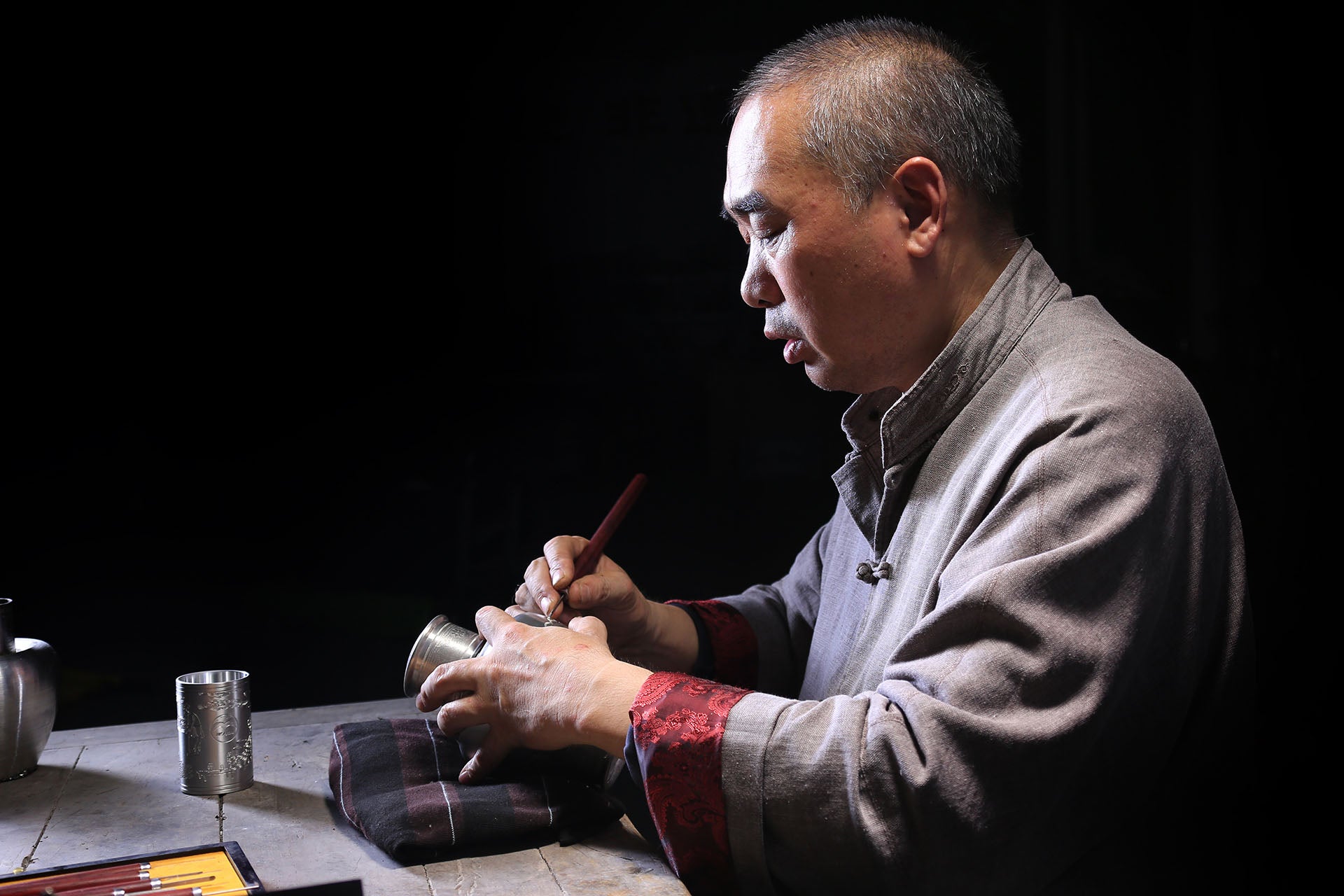
Sheng Yiyuan,ICH Inheritor of Yongkang Tin Carving
Ye Qitong, National ICH inheritor presented 1991 Da Hong Pao tea.
storage

Stable, dry, away from light/odor. Store at room temperature in original packaging for daily use.
I. Container Selection
The original packaging is suitable for storage. If replacing the container, choose odor-free tin cans or double-layered zisha (purple clay) pots. Avoid plastic and glass containers (glass transmits light, accelerating oxidation).
II. Environmental Control
Store in a cool place at room temperature (20-25℃) with a relative humidity of 50%-60%. Keep away from stoves and direct sunlight, and avoid drastic temperature fluctuations.
III. Precautions






